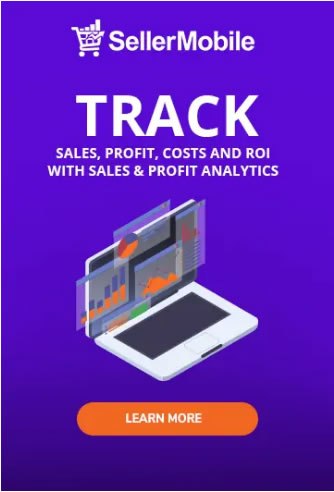Every Amazon seller aims to improve their sales and profits. To achieve that, they should have to consider every area of their business when making decisions. One of these decisions has to do with choosing the right Amazon fulfillment method.
There are only two fulfillment options on Amazon – Fulfillment by Amazon (FBA) and Fulfillment by Merchant (FBM). Each Amazon fulfillment method comes with its own advantages and disadvantages.
Before picking a method, having a clear understanding of their key differences is essential. Not because a certain strategy works for one seller doesn’t mean it would also work for another.
In this article, we’ll discuss how each Amazon fulfillment method works and look at their pros and cons.
No matter what method Amazon sellers choose, Seller Mobile provides comprehensive tools for them to use to ensure they make the most out of their seller’s journey. From inventory management to cost analysis, Seller Mobile ensures you stay ahead of the Amazon competition.
What Is Fulfillment by Amazon (FBA)
FBA stands for Fulfillment by Amazon. Most people think of this selling method when they think of selling on Amazon. With FBA, Amazon fulfills your orders, meaning they pack and ship your orders and deal with customer service issues such as refunds.
FBA lets Amazon sellers take their hands off the logistical aspects of the business and focus on things such as product descriptions and keywords. In this model, sellers ship their products directly to fulfillment centers where Amazon stores, packs, and ships them.
The seller doesn’t have to worry about storage costs and overhead such as packaging fees and refund policies.
With FBA, all your packaging, shipping, returns, and even customer service are handled by Amazon. All you have to do is to send your desired inventory to an Amazon Fulfillment Center and they’ll do the rest.
How Much Does Amazon FBA Cost?
When you choose Amazon FBA, you get charged two types of fees: fulfillment fees and storage fees. Fulfillment fees include the packaging, shipping and handling, customer service, and product returns on items.
Amazon charges fees on a per unit basis, using their weight and size as the baseline. The fee structure is as follows:
Small Items
- Small – 10oz or less – $2.41 per unit
- Small – 10oz to 16oz – $2.48
- Large – 10oz or less – $3.19
- Large – 10oz to 16oz – $3.28
- Large – 1lb to 2lb – $4.76
- Large – 2lb to 3lb – $5.26
- Large – 3lb to 21lb – $5.26 + $0.38/lb above first 3 lb
Oversize Items
- Small oversize (71lb or less) – $8.26 + $0.38/lb above first 2 lb
- Medium oversize (151lb or less) – $9.79+ $0.39/lb above first 2 lb
- Large oversize (151lb or less) – $75.78 + $0.79/lb above first 90 lb
- Special oversize – $137.32 + $0.91/lb. above first 90 lb
FBA charges an additional $0.40/unit for clothing items and $0.11/unit for items containing lithium batteries.
Storage fees accrue monthly per cubic foot that your items occupy. Prices for the storage fees vary based on the season. For example, they increase closer to the holiday season.
Standard-Sized Item Storage Fees
- January – September: $0.69/cubic foot
- October – December: $2.40/cubic foot
Oversize Item Storage Fees
- January – September: $0.48/cubic foot
- October – December: $1.20/cubic foot
Additional FBA Fees
- Long-term storage fees (for stock that has been in fulfillment centers for more than 365 days)
- Removal order fees (if you need to take any of your items out of circulation)
- Returns processing fees (for orders where Amazon offers the customer free returns shipping)
- Unplanned service fees (if your inventory isn’t properly labeled or prepared when it comes to the fulfillment center)
For further information on Amazon fees, visit their website.
Amazon FBA Pros
Saves Time
You save time from packing items and mailing them to your customers. Every time a customer places an order, Amazon ships the item directly to them.
More Space
Amazon handles the storage space for you so you don’t have to fill your house with boxes and products, especially during busy shopping periods. Just make sure your stock up your inventory so you don’t run out of products.
Improves Prime-Eligibilty
With FBA, your products are eligible for Prime shopping. Given that the majority of Amazon shoppers are prime customers, your products become more appealing to them.
Increases Buy Box Chances
Amazon favors FBA sellers when it comes to Buy Box eligibility. And since the competition on Amazon is tough, you have better chances of winning the Buy Box.
Amazon FBA Cons
More Effort
You have to prepare the products yourself before you send them to Amazon’s warehouse. This involves labeling items correctly and following other requirements so you can be sure that they are accepted. Otherwise, Amazon will send your products back and you have to go through the process again.
Charges Storage Fees
Storing your items in Amazon’s warehouse is not for free. You will need to pay for storage fees. If your items are not sold within 180 days, you will be charged long-term storage fees. Thus, it is important that you send just enough inventory and restock efficiently.
Charges Fulfillment Fees
Amazon will do all the dirty work for you, but you have to pay a fee in exchange. Every time a customer places an order, Amazon charges you a certain fee. That said, you have to make sure you understand all the requirements before becoming an FBA seller so you know exactly what your margins and profits will be.
Limits inventory control
Since your items are stored in Amazon’s warehouse, you lose control over some aspects of your inventory, including the packaging. Also, if a problem with your inventory arises, you must rely on Amazon to resolve it.
What Is Fulfillment by Merchant (FBM)?
With FBM, you handle all aspects of Fulfillment. You list your products on Amazon, then store, pack and ship them as your customers order them.
Most of the time, these responsibilities don’t fall squarely on your shoulders. FBM sellers work with third-party logistics companies to manage your supply chain.
Listing on FBM is largely the same as listing one on FBA. The only difference is the fulfillment method you choose. Fulfillment by Merchant means once orders come through, you become responsible for them, ensuring they reach customers.
This method reduces fees but increases responsibilities, so it can be difficult to decipher which method is more cost-effective. The only Amazon seller fees for FBM are the $39.99 for the professional selling plan and the $0.99 per item.
You still have to pay for storage and shipping. However, you can often find cheaper alternatives to FBA with third-party fulfillment centers.
How to List a Product With Amazon’s Fulfillment by Merchant
Amazon FBM makes listing products simple. You can also change shipping methods any time you want. The only difference between Amazon FBA and FBM is where you stipulate how the product should be shipped.
Amazon FBM Pros
Hands-on Fulfillment
Since you handle the fulfillment from A-Z, you have more control over your inventory. You can easily track and restock inventory, as well as, have access to it whenever you need to.
Saves Money on Fees
Being an FBM seller means avoiding storage fees and fulfillment fees associated with Amazon FBA. However, this doesn’t mean you no longer have to pay for storage, fulfillment and shipment expenses
Slightly Higher Margins
By skipping out on Amazon fulfillment fees, you are more likely to earn more on each sale, depending on the product. However, you miss out on the benefits of being Prime, which could drive more sales.
Amazon FBM Cons
More Responsibility
More control over your business means more responsibility to fulfill. You should be on top of your shipping and customer service. Otherwise, your seller metrics will suffer.
Reduced Prime Opportunities
Although seller-fulfilled Prime offers all Amazon sellers the benefits of FBA without the increased FBA fees, the criteria for approval can be quite extensive and stringent. You need to have a professional account with outstanding records and existing premium shipping order volume, among others.
Requires Lower Selling Price
To win the Buy Box and compete with other FBA sellers, you will need to keep your prices low. This may pose a negative impact on your margins and could start a pricing war.
FBA or FBM: What’s best for you?
Now, you know the pros and cons of each Amazon fulfillment method, it’s time to make a decision. Here’s a quick breakdown to find out which method is ideal for you.
FBA fits your business if:
- Your products have a fast turnover
- Your products are small, lightweight and expensive
- You care less about commingling
- You lack the manpower to fulfill orders efficiently while still offering good customer service
FBM fits your business if:
- Your products have a slow turnover
- Your products are big, heavy and cheap
- You find commingling risky
- You have sufficient manpower and storage to fulfill orders efficiently while still offering good customer service
Conclusion – FBA Vs. FBM: Which Amazon Fulfillment Method to Choose?
In conclusion, deciding on an Amazon fulfillment method is challenging. There is no perfect formula to make the decision easier. Plus, there is a load of factors you still have to consider, including the size and needs. As your Amazon business grows, continue to weigh your fulfillment options and make the best decision based on your bottom line.





